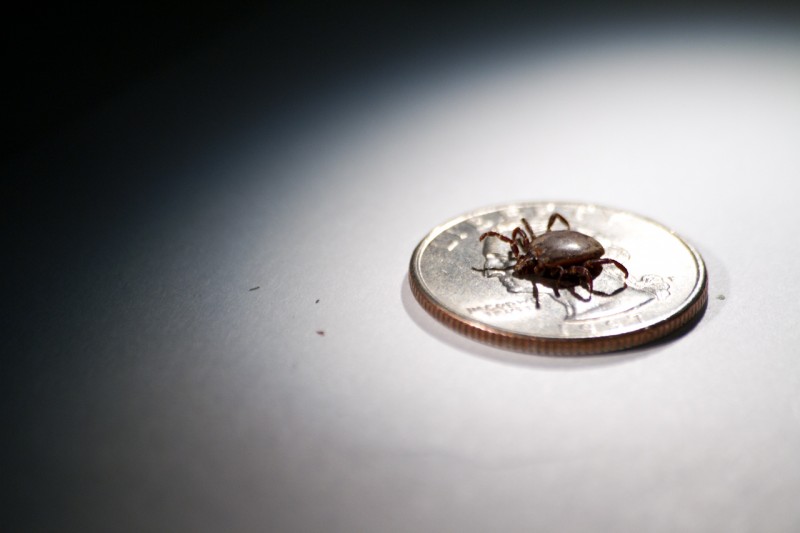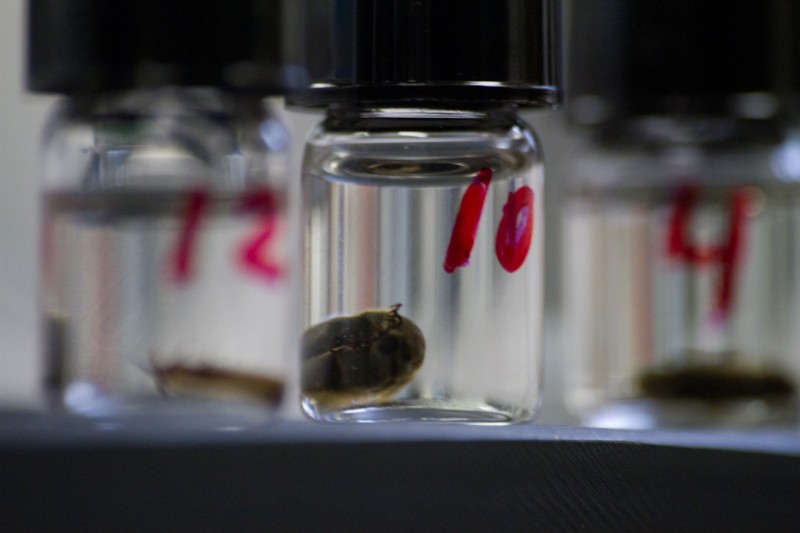
Three years ago, while studying Lyme disease at UNF, Dr. Kerry Clark received complaints from a resident in northern Georgia.
The resident was concerned the thriving number of ticks in her neighborhood were causing cases of Lyme disease. Northern Georgia is an area traditionally thought unaffected by Lyme disease.
Little did Clark, Associate Professor of Public Health, know he would become even more familiar with Lyme disease, both professionally and personally.
The accounts were true — as he walked through the rural neighborhood Clark found an abundance of ticks.
“People were picking up ticks just walking in their lawn,” Clark said.
Clark himself was bitten by several ticks during the trip.

Shortly after, Clark noticed a skin rash on his neck.
Clark went to the doctor, who diagnosed him with Lyme disease. Clark’s doctor put him on a two week antibiotic treatment plan, the typical treatment for Lyme disease. Clark’s skin cleared up and he began to feel better… temporarily.
Several months later, Clark began experiencing extreme fatigue.
“I would come into my office in the morning; I was so exhausted I had to prop my feet up on the chair and just sit here for my eyes closed for 30 minutes. I had no motivation to do anything,” Clark said.
It didn’t stop there.
“One day, I got this splitting headache. It was so intense. Everyday after that, it was a little bit milder but the headache never went away,” Clark said.
Clark began to think his Lyme disease never went away. He had his doctor draw blood for him and he started testing himself.
Sure enough, he tested positive for Lyme disease again.
Lyme disease is a bacterial infection transmitted through the bite of a tick.
Early symptoms of Lyme disease could take place within 3-30 days after a tick bite. The symptoms include fever, headache, fatigue, muscle and joint aches. Another symptom occurring in 70-80 percent of victims is a skin rash called erythema migrans that can grow up to 12 inches, according to the Centers for Disease Control and Prevention. This skin rash is often dubbed the bull’s-eye rash because part of the rash may clear as it grows, resulting in a bull’s-eye appearance.
Clark is familiar with examining images of bull’s-eye tick bites.
He has published several studies concerning Lyme disease. Clark developed techniques in studying lizards and rodents before moving on to humans.
Individuals from all over the country send Clark shipments of ticks hoping he will test them, a sign of his highly regarded reputation in Lyme disease research. Clark asks that ticks be preserved in acetone or alcohol and put into a plastic, leakproof container.
“I’ve definitely been focused, if not obsessed,” Clark said.
His self-proclaimed obsession led him to a groundbreaking discovery on UNF campus. His study was published in the May issue of The International Journal of Medical Sciences. The International Journal of Medical Sciences has open access, meaning anyone can read the study. This was important to Clark because he wanted his research to be available to everyone.
Clark and his two colleagues discovered two species of bacteria, Borrelia andersonii and Borrelia americana, that cause Lyme disease. Until Clark’s work, these species were not previously thought to cause the disease in humans.
Clark’s study helped disprove a few more common myths concerning Lyme disease.
It is widely believed Lyme disease mainly occurs in the Northeast. Clark’s study suggests it is more common in the South than we may think.
One of the reasons for this myth is the confusion between the terms “deer tick” and “black-legged tick” Clark said. “Black-legged tick” is the scientifically correct term. “Deer tick” is the nickname for “black-legged tick.”
It was commonly thought the only ticks that transmit Lyme disease were “deer ticks.” But in the South, the exact same species was called “black-legged ticks.”
Clark’s study, in combination with past studies, tackled another myth and proved the lone star tick can also transmit Lyme disease.

Clark’s discovery is significant in the detection of Lyme disease. If current diagnostic testing doesn’t take into account the two newly-discovered Lyme bacterial species, a Lyme disease patient could be misdiagnosed.
In 2011, the CDC confirmed 78 cases of Lyme disease. Clark said the actual number of Lyme disease victims is much higher.
Whether the number of cases is high or low, Lyme disease is in the South.
Clark said patients in the South can face a dangerous scenario. A patient in the South may go to a doctor with all the symptoms of Lyme disease — a history of a tick bite, skin rash and other flu-like symptoms. But the patient may not even be tested for Lyme disease, and thus go untreated.
“The doctors have all been told there is no Lyme disease down here,” Clark said.
If left untreated, Lyme disease can cause immune suppression. This makes a Lyme disease victim susceptible to other illnesses, Clark said.
Clark’s study focused on ten patients from the South with symptoms of Lyme disease.
A sample of blood or other infected tissue was taken from patients to test for DNA from Lyme-disease-causing bacteria. Clark took similar samples from the ticks that bit some of the patients.
After a series of tests he constructed, Clark discovered the people and ticks both carried genetic markers for the bacteria.
Surprisingly, the strands of bacteria found in both ticks and people in the study were not previously known to cause Lyme disease symptoms.
Clark’s tests of the ticks found one bacteria already known to cause Lyme disease in the lone star tick. The tests also found Borrelia andersonii, one of the bacteria species Clark discovered to cause Lyme disease symptoms.
It was previously thought the only type of tick capable of transmitting Lyme disease was black-legged ticks. However, Clarks tests revealed numerous lone star ticks that tested positive for at least two strains of Lyme bacteria.
Clark’s research helps improve current diagnostic techniques. If Lyme disease is caught early, it can be treated with antibiotics.
Clark compares his research to looking for a needle in a haystack.
“You’ve got a haystack worth of human DNA and maybe a couple of needles of the Lyme Borrelia DNA,” Clark said.
Clark believes there is still much to be discovered about Lyme disease.
“As long as I have funding to do it, I will continue to do it,” Clark said.
Clark’s dedication to Lyme disease research hasn’t gone unnoticed.
“To know how many years he has worked to be able to show others what he believes, I’m excited for him,” Pamela Chally, Dean of Brooks College of Health, said.
Clark’s discovery continues to make the Brooks College of Health increasingly relevant to the community, Chally said.
In the past few years, Clark’s Lyme disease research has been funded by private donors including patients and their family members.
The Northeast Florida Lyme Association also raised $20,000 for his research and presented him with a giant check, currently displayed prominently in his office.
But he admits getting funding isn’t always easy. For one, research isn’t cheap. Clark estimates a need of $10-15,000 in lab supplies alone per year.
But for some, Clark’s work hits close enough to home for them to step in and help raise money.
Dan Boggs is a co-founder of the Northeast Florida Lyme Association. This non-profit organization aims to spread public awareness about the sometimes-misdiagnosed disease. Boggs himself had undiagnosed Lyme disease for three years and went from doctor to doctor to try to figure out what he had. He said there were days he couldn’t get out of bed.
Lyme disease also proves to be difficult to get funding for because his research goes against the misconception that Lyme doesn’t exist in the southern US.
This view can be emotionally taxing for patients.
“When a doctor finally diagnosed me with Lyme disease, my reaction was ‘thank God I finally know what I have. I’m not crazy,’” Boggs said.
Boggs calls Dr. Clark “God sent.” Clark’s research proving Lyme disease can be found in the South is helping victims be proper diagnosed, Boggs said.
“My argument would be if you give me the funding, I’ll prove it’s not rare down here,” Clark said.
As of now, Clark is starting a study testing dogs in the southern US. The location once again reinforces the presence of Lyme disease. Dogs get bitten by ticks more than humans do so he believes it will be a good indicator of Lyme disease infection rates in a specific area, Clark said.
Clark didn’t catch his case fast enough to be treated with antibiotics and Boggs suffered through Lyme disease for years before a doctor diagnosed him properly. Cases like these imply there is still much to discover about Lyme disease.
Clark knows this well. He plans on continuing research in this field.
Email Noor Ashouri at [email protected]































tessa mccall • Sep 10, 2016 at 9:20 pm
Dr Kerry Clark is a kind compassionate researcher. He is very approachable and willing to share his limited time and our family so appreciates it. Dr. Clark tested our little Gracie’s blood over this past summer and discovered she was positive for lyme disease. She had a period of mystery seizures and other mystery illnesses over the past couple years. She was tested both through vet’s office and came back negative. She was on medication to prevent ticks but unfortunately two were found on her over the past couple of years. Her diagnosis came to late unfortunately and she passed away in July. We have been left heart broken that we didnt catch this soon enough as western blot testing for antibodies is not a good test.